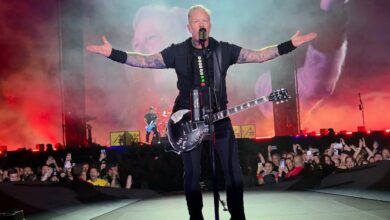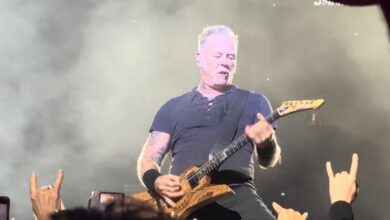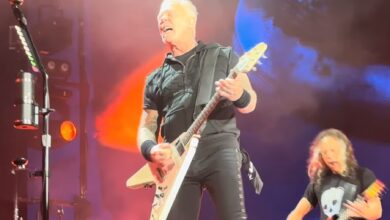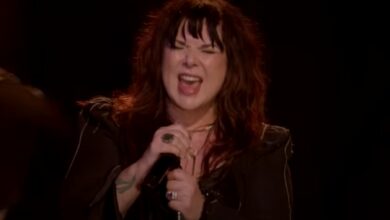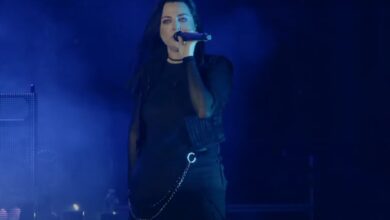A Paris Street Turns Into Rock Opera: The Ultimate Bohemian Rhapsody Flashmob
On September 9, 2025, the streets of Paris were transformed into a rock-opera stage when more than 30 musicians and singers erupted into a flashmob performance of Queen’s “Bohemian Rhapsody.” Pianist Julien Cohen, who orchestrated the spectacle, captured and uploaded it the same day, and the video skyrocketed in popularity, climbing from thousands to nearly half a million views overnight. What made this so breathtaking was not just the music itself, but how it unfolded in the rhythm of daily life. One minute, it was just an ordinary square; the next, it was the epicenter of musical history.
The performance opened gently with three female singers leaning from a café window, their voices weaving together on the iconic first lines. A moment later, Cohen appeared in the square below, seated at his piano, striking the chords that sent the crowd into gasps of recognition. The suddenness of it all—the voices from above, the pianist below—was a masterstroke of planning that instantly hooked the unsuspecting crowd and made them part of something unforgettable.
As the harmonies grew, new performers revealed themselves from balconies and doorways, their entrances timed perfectly to match the operatic layering of the song. The effect was staggering. The normally quiet square now resonated like a theater, echoes bouncing off the stone walls and cobbled ground. People stopped in their tracks, tourists pulled out phones, and locals leaned forward from café chairs, unable to look away. The city’s hum blended seamlessly into the music, as if Paris itself was complicit in the performance.
Then came the theatrical flourish that lifted the flashmob into another dimension. A carriage rolled into the square, and its flamboyant rider, Mickey Callisto, stood tall to deliver his lines with dramatic flair. It was bold, it was flamboyant, it was everything that “Bohemian Rhapsody” represents. His performance channeled Freddie Mercury’s theatricality so vividly that the audience burst into laughter, cheers, and applause all at once.
Just as the crowd thought they had seen it all, a drummer appeared and set up a portable kit, pounding rhythms that thundered through the plaza. At the same time, the star of the day, an 11-year-old guitarist known as “Guitar Olly,” stepped forward. His confident solo work stunned the crowd, his small frame a sharp contrast to the power of Brian May’s riffs that seemed to flow effortlessly from his guitar. People were visibly moved, clapping mid-performance, many shaking their heads in disbelief.
The operatic middle section transformed the square into an open-air theater. Singers leaned dramatically from windows, others gestured passionately toward the crowd, and every corner of the square became alive with voices. The operatic layers, so famously complex, were executed flawlessly and playfully, drawing smiles and laughter as the performers hammed up their roles. The audience responded in kind, their applause and cheers punctuating the beats and pauses of the music like a living metronome.
As the song shifted into its heavier rock section, the atmosphere exploded. Guitar Olly shredded his solo with astonishing skill while the drummer kept pounding, fueling the energy of the crowd. Mickey Callisto waved his arms theatrically from the carriage, his voice soaring above the instruments. Onlookers clapped in time, shouted the words, and joined the performers in turning the square into something that felt larger than life.
By now, the line between audience and performer had disappeared. Café tables were abandoned, strangers linked arms and sang together, and hundreds of voices echoed the famous chorus. The cobbled streets reverberated with chants, laughter, and even tears as people realized they were witnessing something utterly unique. The joy was palpable, infectious, and impossible to fake.
As the crescendo faded into the delicate final section, the atmosphere shifted again. The energy softened, voices harmonized gently, and Cohen’s piano guided the crowd toward a hushed, reverent close. For a few seconds, there was silence—an awed, collective breath—as everyone absorbed what had just happened. Then, the square erupted in thunderous applause, the sound rolling like a wave through the streets.
The performers smiled, waved, and then quietly dispersed, leaving behind stunned faces and buzzing conversations. Some people remained in the square long after, replaying what they had just seen, eager to hold onto the magic. Others rushed to upload their videos, ensuring the performance would spread far beyond Paris.
Online, the flashmob became an overnight sensation. Comments flooded in, describing it as the best flashmob ever staged, a true celebration of Freddie Mercury’s genius. Many viewers said the performance gave them goosebumps, some admitted it brought them to tears, and others marveled at how flawlessly it was executed. For many, the sight of a young boy playing Brian May’s solo with such conviction became a symbol of how music transcends generations.
Julien Cohen’s role as architect of the event cannot be overstated. Known for his spontaneous public performances, he had outdone himself with this ambitious staging. The coordination of singers, instrumentalists, and theatrical elements was nothing short of genius. It elevated the flashmob from a fun surprise into a piece of living performance art, worthy of any concert hall, yet staged for free in the heart of the city.
For those in Paris that day, it was a once-in-a-lifetime experience. People expecting only a quiet walk or coffee run had stumbled into history. Tourists who had planned on ticking off landmarks went home with a story they could never have predicted. It was the very essence of why flashmobs exist: to transform the ordinary into something extraordinary, to remind people of the power of art to surprise, delight, and unite.
More than anything, the flashmob served as a vibrant reminder of Freddie Mercury’s enduring genius. Fifty years after “Bohemian Rhapsody” was first released, it still has the power to stop people in their tracks, to make strangers into choristers, and to electrify a city. On that day in September 2025, in the streets of Paris, the spirit of Queen lived again—not on a stage, but in the hearts of everyone who witnessed it.
